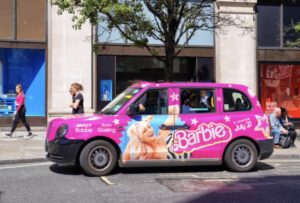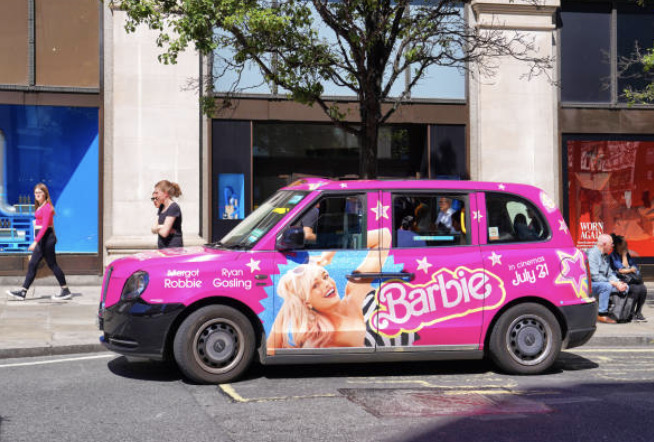On July 21, 2023, herds of women flocked to the halls of movie theaters across the country. Finally, months of marketing had paid off: Barbie was premiering. The film ultimately broke numerous records at the box office, including the biggest opening of 2023 and the highest grossing film by a female director.
From hot pink billboards with nothing but the film’s release date, to the limited edition “Barbie Burger” at the fast food chain Burger King, Barbie’s marketing team spent every last penny of their 150 million dollar marketing budget. In total, the film had over 100 promotional partners. “They have the best marketing I have ever seen in my entire life,” Lick-Wilmerding High School Film Club Co-Leader Brandon Diaz ’26 said.
Several strategies employed by Barbie’s marketing team can potentially be accredited to the film’s success. San Francisco State University (SFSU) Marketing Professor Ian Sinapeulas believes that the general multimedia strategy was a skillful choice. “They went beyond the digital space. Having licenses or partnerships for movies, that’s always been a thing… [but] they complimented the digital with the out of home [traditional marketing],” he said.
The film combined online advertising with more traditional methods, like signage and brand collaborations. This combination of components appealed to different age demographics, younger internet users and older generations who are more familiar with conventional tactics. “Individually they would have minimal effect, but together they had a great impact. [They] never really lost [the consumer’s] attention,” said Sinapeulas.

photo courtesy of Mirabel Adams
A notable element of the marketing campaign was social media engagement. Barbie’s production company, WarnerBros, partially contributed through posts on social media platforms like TikTok or Instagram. However, fan engagement online arguably paved the way for success in the digital space.
Hashtags like #barbiemovie and #barbie garnered millions of views on TikTok. The film even spawned the “Barbenheimer,” trend, a joke poking fun at the film’s dual release with the gritty biopic Oppenheimer.
Box Office Pro, a magazine that focuses on the film industry and movie theater business, estimated that 81 percent of Barbie’s audience was under the age of 35. Greta Samaha ’26, LWHS Film Club Co-Leader, believes that the usage of social media brought in revenue from young people. “That’s how we communicate. [In the past] people found movies and watched them just by going to the theater, but we find out about them through videos,” she said.
Another SFSU Marketing Professor Sanjit Sengupta discussed the differences of this relatively new strategy in comparison to past forms of marketing. “Established companies have had to learn this new technique,” he said, “In social media… people can write whatever they feel. [You have] a two way conversation between the company and the consumer.” By engaging in digital marketing via social media, the Barbie team received insight into consumers’ thoughts, allowing them to strengthen their approach based on this feedback.

photo courtesy of SCA Photography + Media
Another vital piece of the marketing campaign was demographic-based marketing, namely marketing towards women. According to a 2018 study from the Creative Artists Agency, an LA based talent agency, films starring women or that pass the Bechdel Test (a measure of female representation that asks whether a work features at least two women who talk to each other about something other than a man) often earn more than male led films.
In contrast, IMDb’s top 50 highest grossing films are overwhelmingly male, including action movies like Fast and Furious and a majority of the Marvel franchise. “Women have not had enough movie offerings for them,” said Sengupta. Barbie’s advertising leaned into the girlish aesthetic associated with the toy, promising a celebration of femininity.
Moreover, Barbie went beyond solely targeting women with licensing deals for traditionally female-marketed products (i.e. beauty, fashion, etc) and appealing visuals. Many women felt a pre-existing emotional connection to the content. “People can keep criticizing it [the film] … but overall, it did what it came to do. It touched on the female experience through Barbie, which played a role in a lot of girls’ lives,” said Samaha.
A recent Time Magazine article titled, “We’re Ignoring the Real Reason Barbie Might Dominate the Box Office,” points to a similar explanation, attributing Barbie’s success to its representation for all types of women. Sinapeulas believes that profitable identity-based marketing must go beyond surface level, empathizing with the desires of the consumer. “Just because [certain demographics] look the same on paper doesn’t necessarily mean that they have the same needs. You need to go beyond the demographics and say ‘Hey what do these [people] need?’,” he said.
While the “target demographic” of Barbie is up for interpretation, some consumers have self-identified several probable groups. Simone Edwards ’24, for example, believes that women and young people were central to the marketing campaign. “I [felt] like it was definitely for teenage girls, like young girls. It was like this, ‘We’re going to empower you’ kind of thing,” she said.

photo by Mayen Thorsen ’25
The target demographic may not have even been rooted in identity. Sinapuelas said that good marketing can also focus on consumer’s beliefs, rather than demographics. “I think we’ve gotten past looking at gender, [now] we’ve got, What are your values as a consumer? How do you relate to feminism? Are you against it?” he said.
Barbie incorporated several political messages into the casting and themes of the film. The main topic of the film was feminism, and how it relates to the original toy. The marketing seemed to hint at this theme, particularly with the “This Barbie” advertisements which contrasted the illustrious careers of various Barbies with the “He’s just Ken” slogan attached to each “Ken”.
Additionally, the film cast a very diverse group of women. While the lead actress of the film, Margot Robbie, is a cisgendered, straight white woman, her co-stars included actresses of different races and sexual orientations, with one of the actresses identifying as transgender. These progressive presenting values exhibited prior to the film’s release could be seen as an additional marketing technique, targeting the average liberal consumer.
Despite the success of the film and marketing campaign, Barbie did not resonate with everyone. “It was just so over simplified,” said Edwards when asked about the feminism within the film. Barbie received criticism in some reviews due to its lack of intersectionality within the feminist dialogue. “We have these straw men that you can read into, but they actually don’t… deeply engage the conversation…in a way for it to be truly intersectional,” said LWHS history teacher and upperclassmen dean, Kindra Briggs.
While the political messaging in the marketing and film may have fallen short for some, Barbie’s attempt at appealing to a socially aware audience illustrates the potential of value based marketing. Barbie’s marketing paved the way for future companies to implement similar tactics, perhaps better fulfilling the promise of representation.
As the Barbie movie posters are slowly stripped down, and the film begins to leave theaters, the lasting impact of the film is undeniable. Many believe that Greta Gerwig, the film’s director, paved the way for future feminist discourse in the film community.






